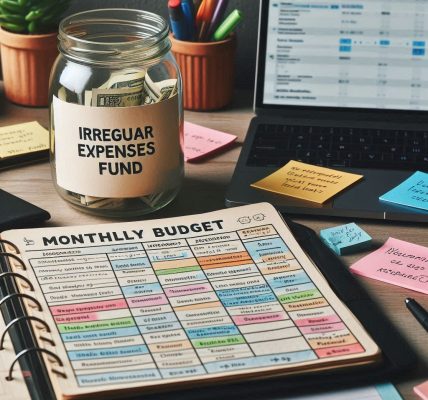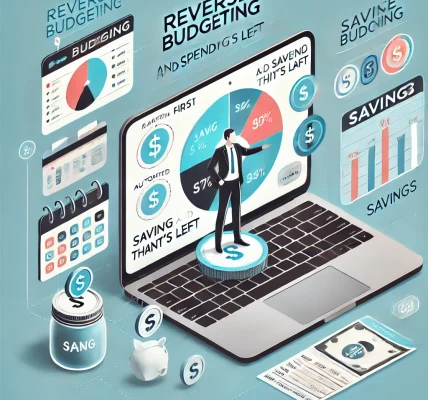📚 Introduction:
As the year comes to a close, it’s the perfect time to review your budget and spending habits. A year-end budget review helps you assess your financial progress, identify areas for improvement, and create a more efficient plan for the upcoming year.
Analyzing your spending habits not only ensures that you stay on track with your financial goals but also prevents unnecessary expenses and helps you prepare for future challenges.
In this comprehensive guide, we’ll explore how to conduct a year-end budget review effectively and adjust your spending habits to maximize savings and achieve long-term financial stability.
🎯 Why a Year-End Budget Review is Important
A year-end budget review provides a clear picture of where your money went throughout the year. It helps you:
✅ Identify Overspending Patterns: Recognize areas where you may have spent more than planned.
✅ Refocus on Financial Goals: Realign your budget with your long-term financial goals.
✅ Adjust for Life Changes: Update your budget to accommodate any changes in income or expenses.
✅ Plan for the Future: Prepare for upcoming expenses, emergencies, and investments.
🚨 Pro Tip:
Conducting a thorough review gives you better control over your finances and ensures a strong financial foundation for the year ahead.
📊 Step-by-Step Guide to Conducting a Year-End Budget Review
🧾 Step 1: Gather All Financial Data
To conduct an accurate year-end review, gather all relevant financial documents from the past year.
✅ What to Collect:
- Bank statements
- Credit card statements
- Receipts for major purchases
- Investment account summaries
- Tax documents
- Utility and subscription payments
🚨 Pro Tip:
Use budgeting apps like Mint, YNAB (You Need a Budget), or Personal Capital to automate tracking and analysis.
📉 Step 2: Analyze Your Income Sources
Evaluate all income sources to understand how much money you made over the year.
✅ Include All Income Sources:
- Primary salary or wages
- Side hustle earnings
- Investment income
- Bonuses, gifts, and refunds
🚨 Pro Tip:
If you have multiple income streams, categorize them to get a clear overview of your total earnings.
💸 Step 3: Categorize and Review Expenses
Break down your expenses into categories to identify spending patterns and analyze where most of your money went.
✅ Expense Categories to Consider:
- Fixed expenses (rent, mortgage, utilities)
- Variable expenses (groceries, dining out, entertainment)
- Discretionary expenses (shopping, hobbies, subscriptions)
- Debt payments (loans, credit card balances)
- Savings and investments
🚨 Pro Tip:
Identify recurring expenses and eliminate unnecessary subscriptions or services.
📊 Step 4: Compare Actual Spending with Your Budget
Once you categorize your expenses, compare them with your original budget.
✅ Identify Key Trends:
- Where did you overspend?
- Where did you stay under budget?
- Are there areas where you consistently exceeded your budget?
🚨 Pro Tip:
Look for hidden expenses that may not have been accounted for initially.
💰 Step 5: Evaluate Savings and Debt Progress
Assess how well you met your savings goals and reduced your debt over the year.
✅ Questions to Ask:
- Did you contribute consistently to your emergency fund?
- Were you able to meet retirement savings targets?
- How much progress did you make in paying off debt?
🚨 Pro Tip:
If you fell short on savings or debt reduction, reallocate discretionary spending to these priorities next year.
📊 Step 6: Analyze Financial Goals and Set New Ones
Reflect on your financial goals for the year and evaluate your progress.
✅ Goal Categories to Review:
- Short-term goals (vacations, emergency fund)
- Medium-term goals (buying a home, paying off loans)
- Long-term goals (retirement, investment portfolio)
🚨 Pro Tip:
Set SMART financial goals (Specific, Measurable, Achievable, Relevant, and Time-bound) for the upcoming year.
📝 Step 7: Identify Spending Leaks and Cut Unnecessary Expenses
During your review, identify areas where money is leaking out of your budget unnecessarily.
✅ Common Budget Leaks:
- Subscription services you no longer use
- Frequent dining out or impulse shopping
- Overpaying for utilities or insurance
🚨 Pro Tip:
Use the ‘Cancel and Save’ approach—cancel unnecessary subscriptions and redirect those funds toward savings.
📊 Step 8: Check for Lifestyle Inflation
Evaluate whether your spending increased as your income grew (known as lifestyle inflation).
✅ Signs of Lifestyle Inflation:
- Increased discretionary spending without savings growth
- Higher spending on luxury items or non-essentials
🚨 Pro Tip:
To prevent lifestyle inflation, maintain a consistent savings rate even when income increases.
📉 Step 9: Adjust Budget Categories for the New Year
Based on your analysis, adjust your budget categories for the upcoming year.
✅ Key Adjustments to Consider:
- Increase or decrease spending limits in specific categories.
- Allocate more towards savings or investments.
- Set aside funds for anticipated large expenses.
🚨 Pro Tip:
Use the 50/30/20 budgeting method to balance your needs, wants, and savings.
📆 Step 10: Create an Action Plan for the New Year
The final step is to develop an action plan to improve your financial habits.
✅ What to Include in Your Plan:
- Set monthly check-ins to review spending.
- Automate savings and debt payments.
- Monitor and update financial goals regularly.
🚨 Pro Tip:
Create a ‘budgeting checklist’ to follow throughout the year.
🎉 Common Mistakes to Avoid During a Year-End Budget Review
❌ 1. Ignoring Small Expenses: Small purchases can add up and derail your budget.
❌ 2. Not Accounting for Irregular Expenses: Include one-time expenses like gifts or medical bills.
❌ 3. Forgetting to Update Goals: As life changes, financial goals should be adjusted.
❌ 4. Failing to Plan for Emergencies: Ensure that an emergency fund is part of your updated budget.
💡 How to Improve Your Spending Habits After a Year-End Review
✅ 1. Automate Savings and Bill Payments
Automating payments ensures you never miss a deadline and builds consistent savings habits.
✅ 2. Use Budgeting Apps to Monitor Spending
Apps like YNAB, Mint, and PocketGuard help you track your spending in real time.
✅ 3. Implement the Envelope System Digitally
If you prefer a hands-on approach, the envelope system can help control variable expenses.
✅ 4. Schedule Quarterly Budget Reviews
Don’t wait until the end of the year—schedule quarterly reviews to stay on track.
✅ 5. Identify and Replace Bad Financial Habits
Pinpoint areas where you overspend and replace them with budget-friendly alternatives.
📝 Legal and Tax Considerations to Keep in Mind
When conducting a year-end budget review, ensure you’re legally compliant and aware of potential tax obligations.
✅ Update Tax Information: Reflect income changes in your tax planning.
✅ Record All Deductions: Identify deductible expenses to minimize tax liability.
✅ Verify Investment Transactions: Ensure compliance with investment tax laws.
🚨 Pro Tip:
Consult a certified financial planner (CFP) or tax advisor to avoid legal pitfalls.
🎯 Conclusion: Take Control of Your Finances for the New Year
A thorough year-end budget review sets the stage for a financially successful new year. By analyzing your income, expenses, and spending patterns, you can create a refined budget that aligns with your goals and safeguards your financial future.
✅ Remember: Small changes in spending habits can lead to significant improvements in your overall financial health. Take control of your finances today and build a solid foundation for tomorrow.




